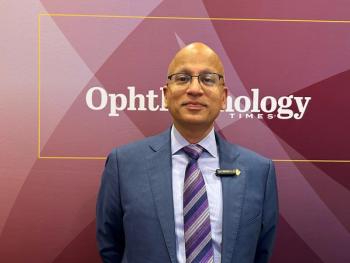
Structural imaging important in glaucoma management
The likelihood of detecting change increases as the frequency offollow-up imaging increases.
São Paulo, Brazil-Imaging is an essential part of glaucoma management, and structural damage is frequently apparent before identifiable visual field loss occurs.
However, available evidence from studies evaluating progression detection through imaging or with visual fields suggests functional testing and quantitative structural imaging should both be performed in eyes with either early or moderate disease, said David F. Garway-Heath, MD.
Dr. Garway-Heath, consultant ophthalmologist, Moorfields Eye Hospital, London, addressed the question of what is the best way to detect change in the optic disc and retinal nerve fiber layer (RNFL) during a glaucoma symposium held during the World Ophthalmology Congress.
"There are data in the literature reinforcing the utility of having a baseline drawing for comparison in serial follow-up," Dr. Garway-Heath said.
In deciding what imaging technique to use, stereodisc photography should be considered the minimum requirement for detecting structural glaucomatous progression in patients with suspected and established glaucoma. Simultaneous stereoscopic photography is preferred over sequential stereophotography because it affords a constant representation of depth scale in the image.
The advantages of optic disc photography are that it alone provides full color, resolution is high, and the images it provides are similar to what the ophthalmologist sees in the clinical evaluation. However, there are also limitations.
"Obtaining good image quality is difficult in eyes with media opacity, there is a lack of adequate systems for viewing the photos in the clinic, interpretation is highly subjective and observer-dependent, and changes that occur cannot be quantified," Dr. Garway-Heath explained.
Modern imaging devices, including confocal scanning laser tomography, scanning laser polarimetry, and optical coherence tomography, provide objective data and measurements that are highly repeatable. Nevertheless, these devices still lack statistical support, and clinical relevance of their findings remains uncertain because it is not known how to translate the structural change they detect into future functional loss.
For all patients, it is recommended that several baseline images be obtained. The likelihood of detecting change increases as the frequency of follow-up imaging increases. While there are no hard and fast rules regarding how often the tests should be repeated, in general the frequency of serial imaging will depend on the individual's risk of progression.
"Regardless of what device is used, it is important to be sure the quality is good because image quality affects repeatability and the ability to detect change," said Dr. Garway-Heath.
Progression in serial images can be evaluated either by looking for a progression event, which determines whether there is a change in follow-up that exceeds some predefined threshold criterion, or with a trend analysis, which considers how fast the disease is progressing over time. In high-risk patients and younger individuals, rate of change is important and that requires investing significant resources to obtain frequent images, whereas the event-type approach, which requires fewer images, is suitable in lower-risk situations.
In a recent publication, Dr. Garway-Heath and colleagues described a new statistical technique for trend analysis of serial retinal and optic nerve head images obtained using scanning laser tomography involving a pixel-by-pixel analysis of topographic height over time. The potential advantage of that method is that significance limits for change are derived based on individual data without involving any reference dataset.
Newsletter
Don’t miss out—get Ophthalmology Times updates on the latest clinical advancements and expert interviews, straight to your inbox.



















































.png)


